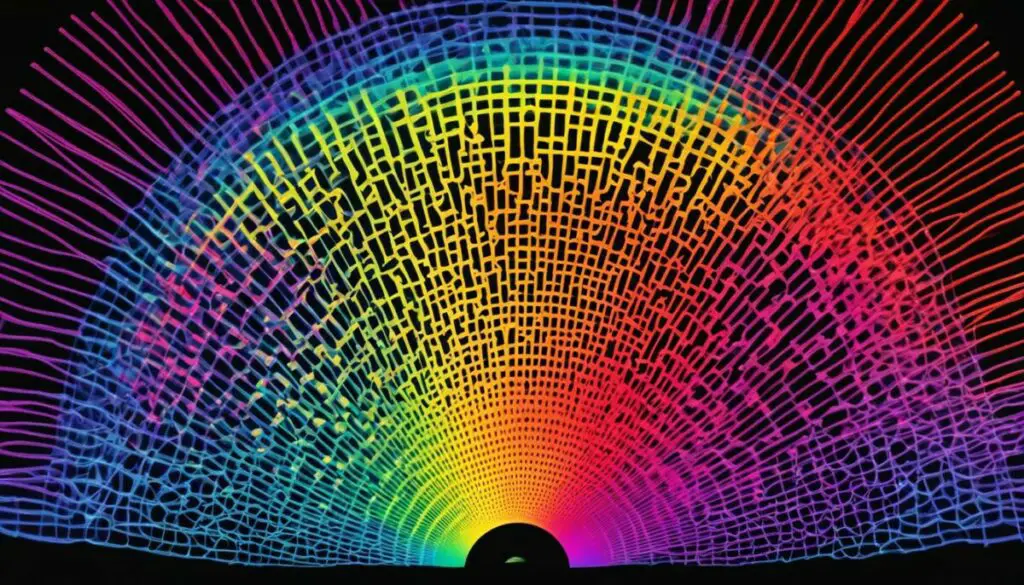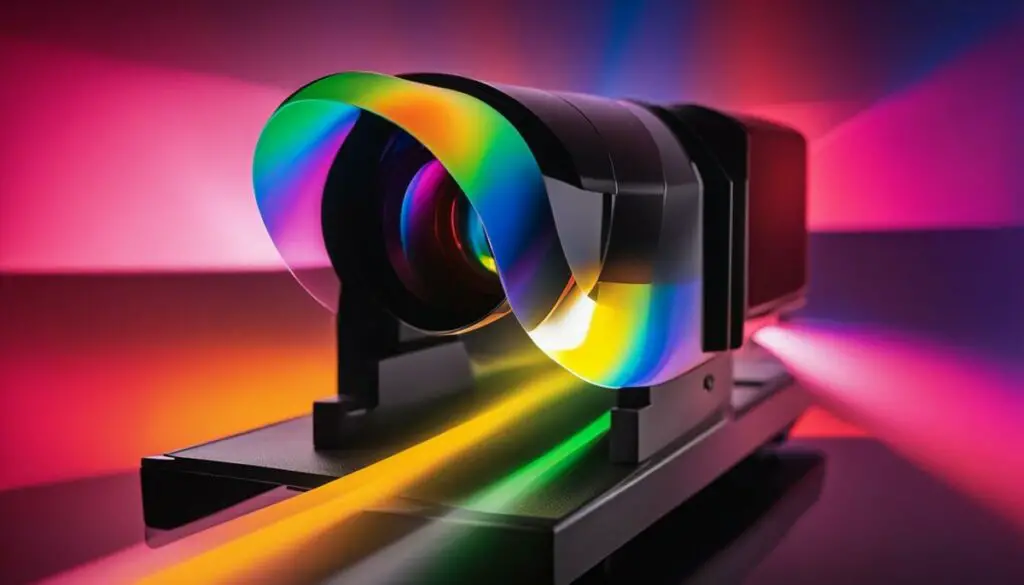Last Updated on 4 months by Francis
Are you curious about the capabilities of a spectroscope in detecting infrared wavelengths? In this article, we will explore the fascinating world of infrared detection and the applications of spectroscopy in infrared spectroscopy.
Contents
Key Takeaways:
- A spectroscope is capable of detecting infrared wavelengths.
- Infrared light has longer wavelengths and lower energy compared to visible light.
- Spectroscopes can analyze the interaction of infrared radiation with matter through absorption, emission, or reflection.
- Infrared spectroscopy is a valuable tool in various scientific fields, including organic chemistry, material analysis, and astronomy.
- The James Webb Space Telescope revolutionizes infrared observations in space.
Understanding Electromagnetic Radiation

Electromagnetic radiation is a broad spectrum that includes various types of waves, such as visible light and infrared light. These waves propagate through space at a constant speed, known as the speed of light, which is about 300 million meters per second.
Different waves within the electromagnetic spectrum have distinct wavelengths and energies. Shorter wavelengths correspond to higher energy levels, while longer wavelengths have lower energy levels. This fundamental relationship between wavelength and energy is crucial to comprehend when discussing the capabilities of spectroscopes in detecting infrared wavelengths.
Infrared light, a subset of electromagnetic radiation, has longer wavelengths and lower energy compared to visible light. While the human eye cannot detect infrared light, it plays a significant role in various scientific fields, including spectroscopy and remote sensing.
“The electromagnetic spectrum is a vast and fascinating domain that encompasses a wide range of wavelengths, each with its distinct characteristics.”
Understanding the nature of electromagnetic radiation is essential for appreciating how spectroscopes can recognize and analyze infrared wavelengths. By harnessing the power of electromagnetic radiation, scientists have developed tools that can unlock valuable insights about the world around us.
| Electromagnetic Wave Type | Wavelength Range | Energy Level |
|---|---|---|
| Gamma rays | Less than 0.01 nanometers | High |
| X-rays | 0.01 nanometers to 10 nanometers | High |
| Ultraviolet (UV) rays | 10 nanometers to 400 nanometers | High |
| Visible light | 400 nanometers to 700 nanometers | Medium |
| Infrared (IR) rays | 700 nanometers to 1 millimeter | Low |
| Microwaves | 1 millimeter to 1 meter | Low |
| Radio waves | Above 1 meter | Low |
The Energy of Infrared Radiation

Infrared radiation possesses a specific energy associated with its wavelength, frequency, and Planck’s constant. The energy of infrared radiation can be calculated using the formula E = hc/λ, where E represents energy, λ denotes wavelength, c symbolizes the speed of light, and h is Planck’s constant. This formula reveals that as the wavelength of infrared radiation increases, its energy decreases.
Notably, infrared radiation encompasses wavelengths ranging from 780 nanometers to 0.3 millimeters, corresponding to frequencies in the range of 1013 to 1014 Hz.
Understanding the energy of infrared radiation is crucial in comprehending how spectroscopes detect and analyze it. By quantifying the energy based on wavelength, frequency, and Planck’s constant, scientists can gain insights into the interactions and properties of infrared radiation in various scientific fields.
Vibrational Modes and Infrared Absorption

Molecules have the remarkable ability to vibrate in different ways, known as vibrational modes. These molecular vibrations play a crucial role in infrared spectroscopy, where molecules absorb infrared radiation at frequencies that correspond to their vibrational frequencies. When a molecule absorbs infrared light, it undergoes a change in its vibrational energy state, providing valuable information about its chemical structure and composition.
Different types of molecular bonds and functional groups have distinct absorption frequencies in the infrared region. By analyzing these absorption frequencies, spectroscopes can identify the presence of specific functional groups in a sample. This allows scientists to gain insights into the molecular vibrations and structural characteristics of the molecules under study.
For example, consider the stretching and bending motions of a diatomic molecule, such as carbon dioxide (CO2). This molecule consists of two oxygen atoms bonded to a central carbon atom. Infrared spectroscopy reveals specific absorption bands corresponding to the stretching and bending vibrations of the CO2 molecule. The characteristic absorption frequencies associated with these vibrational modes provide a unique “fingerprint” that can be used for identification and analysis.
In addition to diatomic molecules, more complex molecules exhibit a myriad of vibrational modes due to the presence of multiple bonds and functional groups. Polyatomic molecules can have stretching and bending vibrations associated with various bonds, such as carbon-hydrogen (C-H), carbon-carbon (C-C), and carbon-oxygen (C-O) bonds. Each of these bonds has its own distinct absorption frequencies, enabling the detection and characterization of specific molecular structures.
To better illustrate the concept of vibrational modes and infrared absorption, let’s take a look at the following table:
| Vibrational Mode | Functional Group | Absorption Frequency (cm-1) |
|---|---|---|
| Stretching vibration | Carbonyl group (C=O) | 1700-1750 |
| Stretching vibration | Hydroxyl group (O-H) | 3200-3600 |
| Bending vibration | Alkene group (C=C) | 650-1000 |
This table provides a glimpse into the characteristic absorption frequencies of various vibrational modes in different functional groups. By comparing the observed absorption frequencies in an infrared spectrum to these reference values, scientists can identify the presence of specific functional groups in a sample, aiding in the determination of its chemical composition.
Exciting the Vibrational Modes
The excitation of vibrational modes in molecules can be seen as the energy quantization of atomic motion within the molecule. As infrared radiation matches the energy levels associated with these modes, it causes the absorption of specific frequencies of light. Consequently, this absorption leads to changes in the vibrational energy states of the molecule, resulting in distinct peaks in the infrared spectrum.
“Infrared spectroscopy allows us to probe the molecular vibrations that shape the unique fingerprints of chemical substances,” says Dr. Amanda Johnson, a renowned spectroscopist.
“It’s like listening to a symphony of molecular movements, each with its own rhythm and melody. By discerning these vibrations, we gain valuable insights into the molecular structure and composition of matter.”
Understanding the vibrational modes and infrared absorption provides a powerful tool for researchers in various scientific disciplines, from chemistry to materials science. It allows them to unravel the mysteries hidden within molecular vibrations and explore the intricate dance of atoms that ultimately defines the physical and chemical properties of matter.
The Power of Infrared Spectroscopy

Infrared spectroscopy is a powerful technique that plays a crucial role in identifying and analyzing chemical substances. By utilizing the unique characteristics of infrared radiation, spectroscopes can provide valuable insights into the composition and structure of a sample.
One of the key strengths of infrared spectroscopy lies in its ability to identify functional groups within a molecule. Different functional groups exhibit characteristic absorption frequencies in the infrared region, allowing spectroscopes to determine their presence in a sample. This information is essential for understanding the chemical nature of substances and their potential applications.
The strength of the absorption observed in an infrared spectrum is directly related to the polarity of the bond and the associated change in dipole moment. Bonds with higher polarities tend to exhibit stronger absorptions, indicating their presence in the molecule. This knowledge of bond polarity provides valuable insight into the molecular structure and chemical properties of a substance.
Furthermore, infrared spectroscopy can also identify bonds that are infrared inactive, meaning they do not absorb infrared light. These bonds often do not possess a significant change in dipole moment upon absorption, leading to a lack of infrared absorption bands in the spectrum. This information can be crucial for the accurate characterization of molecules and the identification of specific chemical bonds.
| Advantages of Infrared Spectroscopy | Applications |
|---|---|
|
|
Overall, the power of infrared spectroscopy lies in its ability to provide invaluable information about the functional groups, bond polarity, and bond strength within a molecule. This technique is widely used in various scientific fields and industries, making it a fundamental tool for chemical analysis and characterization.
Applications of Infrared Spectroscopy

Infrared spectroscopy is a versatile technique with a wide range of applications across various scientific fields. Its ability to analyze the interaction of infrared radiation with matter makes it invaluable in understanding and characterizing different substances.
Analyzing Organic Molecules
In the field of organic chemistry, infrared spectroscopy plays a crucial role in analyzing and characterizing organic molecules. By examining the absorption patterns of infrared light, scientists can identify the functional groups present in a compound. This information helps in determining the structure and composition of organic molecules.
Material Analysis
Infrared spectroscopy is extensively used in material analysis to identify and verify known and unknown samples. It enables scientists to determine the chemical composition and structure of materials by analyzing their infrared spectra. This information is vital in fields such as forensics, pharmaceuticals, and environmental monitoring.
Astronomical Observations
Astronomy benefits greatly from infrared spectroscopy, allowing scientists to study celestial objects and their composition. By analyzing the infrared spectra of stars, galaxies, and interstellar materials, valuable insights into their properties and formation can be gained. Infrared observations also contribute to our understanding of the universe’s evolution and the presence of organic molecules in space.
Applications of Infrared Spectroscopy
| Fields | Applications |
|---|---|
| Organic Chemistry | Analyzing and characterizing organic molecules |
| Material Analysis | Identifying and verifying known and unknown samples |
| Astronomy | Studying celestial objects and their composition |
With its widespread applications, infrared spectroscopy plays a crucial role in advancing scientific research across multiple disciplines.
Infrared Spectroscopy with the James Webb Space Telescope

The James Webb Space Telescope (JWST) is a revolutionary instrument designed for advanced infrared observations in space. Equipped with state-of-the-art spectroscopic capabilities, the JWST enables scientists to capture detailed infrared spectra of celestial objects, unveiling valuable insights about the universe.
Unprecedented Infrared Observations
The JWST’s cutting-edge instrumentation, including the Near-Infrared Spectrograph (NIRSpec), empowers astronomers to explore the universe in unprecedented detail. By harnessing the power of infrared spectroscopy, the JWST can unravel the mysteries of distant galaxies, exoplanets, and other celestial phenomena.
With its advanced optics and highly sensitive detectors, the JWST can capture infrared spectra with unrivaled resolution and sensitivity. This allows scientists to analyze the unique absorption patterns of celestial objects, revealing crucial information about their composition, temperature, and physical properties.
The Microshutter Array Advantage
One of the key technological breakthroughs of the JWST is its utilization of a microshutter array. This innovative array allows the telescope to simultaneously capture spectra from multiple objects in the field of view. By combining this capability with the power of infrared spectroscopy, the JWST maximizes its efficiency and opens doors to comprehensive space observations.
The microshutter array consists of thousands of tiny shutters, each independently adjustable. These shutters can be opened or closed to selectively observe specific celestial objects or regions of interest. This capability enables astronomers to conduct detailed studies of multiple targets within a single observation, greatly enhancing the productivity and scientific output of the JWST.
The Infrared Universe Revealed
With the James Webb Space Telescope, scientists can delve into the infrared universe like never before. By collecting and analyzing infrared spectra, the JWST unveils the hidden secrets of celestial objects, providing a deeper understanding of their formation, evolution, and interactions.
Through its infrared spectroscopic capabilities and the remarkable microshutter array, the JWST is poised to revolutionize our understanding of the universe. From unraveling the mysteries of star formation to probing the atmospheres of distant exoplanets, this extraordinary telescope opens new frontiers of knowledge and inspires awe-inspiring discoveries.
Practical Considerations for IR Spectroscopy

When conducting IR spectroscopy, proper sample preparation is essential to ensure accurate and meaningful results. Different types of samples, such as gas, liquid, or solid, require specific techniques to facilitate measurement and analysis.
Gas Samples
Gas samples in IR spectroscopy are often dilute, requiring a sample cell with a long path length to compensate for the low concentration. This ensures sufficient interaction between the infrared radiation and the gas molecules. By using a longer sample cell, the sensitivity and accuracy of the measurements can be improved.
Liquid Samples
For liquid samples, sandwiching them between salt plates is a common technique in IR spectroscopy. Salt plates, typically made of sodium chloride (NaCl), are optically transparent in the infrared range. The liquid sample is placed between two salt plates, creating a thin film. This technique allows for accurate measurement of the liquid sample’s absorption properties without interference from the salt plates.
Solid Samples
Solid samples in IR spectroscopy can be prepared in different ways depending on their properties and desired analysis. Thin films or pressed pellets are commonly used techniques. Thin films are obtained by depositing a thin layer of the solid sample onto a suitable substrate, such as a salt plate or a reflective surface. Pressed pellets, on the other hand, involve compressing the solid sample into a disc shape using a hydraulic press. Both techniques ensure that the solid sample is in a suitable form for accurate analysis.
Proper sample preparation is crucial for obtaining reliable results in IR spectroscopy. By employing the appropriate techniques for gas, liquid, and solid samples, researchers can ensure the accuracy and sensitivity of their measurements.
Summary:
- Gas samples in IR spectroscopy require a long path length to compensate for their diluteness.
- Liquid samples can be sandwiched between salt plates to enable accurate measurement of their absorption properties.
- Solid samples are typically prepared as thin films or pressed pellets for proper analysis.
Interpreting IR Spectra
Interpreting IR spectra is a crucial step in understanding the chemical composition and structure of a substance. By analyzing the absorption bands and identifying the molecular vibrations associated with specific functional groups, scientists can determine the presence of these groups in a sample.
Each absorption band in an IR spectrum corresponds to a specific vibrational mode and bond type. These bands are a result of the interaction between the infrared radiation and the molecular vibrations of the sample. Different functional groups have their characteristic absorption frequencies, allowing for their identification in the spectrum.
“The interpretation of IR spectra is like solving a puzzle. Each absorption band provides a clue about the molecular vibrations and the functional groups present in the sample.”
To interpret an IR spectrum, scientists compare the observed absorption bands to reference spectra and known functional group frequencies. By matching the absorption bands to these references, they can determine the presence of specific functional groups in the sample. This process is crucial for accurate functional group identification.
Table: Functional Group Frequencies in IR Spectroscopy
| Functional Group | Wavenumber (cm-1) |
|---|---|
| Alcohol | 3200-3500 |
| Carbonyl (aldehyde) | 1700-1799 |
| Carbonyl (ketone) | 1680-1750 |
| Amide | 1600-1699 |
| Alkene | 1600-1660 |
By combining the information gleaned from the absorption bands and the known functional group frequencies, scientists can gain a deeper understanding of the molecular structure and chemical properties of the substance under study.
Conclusion
In conclusion, spectroscopy is a powerful technique that allows scientists to detect and analyze infrared wavelengths. With its ability to analyze the interaction of infrared radiation with matter, spectroscopy finds applications in various scientific fields. In organic chemistry, it helps in the identification and characterization of organic molecules. In material analysis, it assists in the verification and analysis of known and unknown samples. In addition, spectroscopy plays a crucial role in astronomical observations by providing insights into the composition and properties of celestial objects.
The advancements in technology, such as the James Webb Space Telescope (JWST), have revolutionized infrared observations in space. Equipped with advanced spectroscopic capabilities, the JWST is able to capture detailed infrared spectra of celestial objects. Its innovative microshutter array enables simultaneous spectra capture from multiple objects, facilitating more comprehensive observations of the infrared universe.
By understanding the principles of infrared spectroscopy and employing proper sample preparation techniques, scientists can obtain valuable insights into the composition and properties of substances. Interpreting infrared spectra allows for the identification of molecular vibrations and specific functional groups, enabling a deeper understanding of the chemical composition and structure of a substance. In summary, infrared spectroscopy is a powerful tool that enables scientists to explore and understand the invisible world of infrared radiation.
FAQ
Can a spectroscope detect infrared wavelengths?
Yes, spectroscopes are capable of detecting infrared wavelengths. Infrared light, also known as thermal radiation, has longer wavelengths and lower energy compared to visible light. Spectroscopes can analyze the interaction of infrared radiation with matter by absorption, emission, or reflection, making them valuable tools in various scientific fields, including infrared spectroscopy.
What is the energy of infrared radiation?
The energy of infrared radiation depends on its wavelength. Infrared radiation has longer wavelengths and lower energy compared to visible light. The energy can be quantified using the formula E = hc/λ, where E is energy, λ is wavelength, c is the speed of light, and h is Planck’s constant. As the wavelength of infrared radiation increases, the energy decreases.
How does infrared spectroscopy work?
Infrared spectroscopy takes advantage of the fact that molecules absorb infrared radiation at frequencies that match their vibrational frequencies. When a molecule absorbs infrared light, it undergoes a change in its vibrational energy state. By analyzing these absorption frequencies, spectroscopes can identify the presence of specific functional groups in a sample.
What are the applications of infrared spectroscopy?
Infrared spectroscopy has a wide range of applications in various scientific fields. In organic chemistry, it is used for analyzing and characterizing organic molecules. It is also used in material analysis to identify and verify known and unknown samples. In astronomy, infrared spectroscopy enables the study of celestial objects and their composition.
How is infrared spectroscopy used in space observations?
The James Webb Space Telescope (JWST) is a groundbreaking instrument for infrared observations in space. Equipped with advanced spectroscopic capabilities, the JWST can capture infrared spectra of celestial objects with unprecedented detail. Its instruments, including the Near-Infrared Spectrograph (NIRSpec), use a microshutter array to capture spectra from multiple objects simultaneously, allowing for more efficient and comprehensive observations of the infrared universe.
What are some practical considerations for infrared spectroscopy?
IR spectroscopy requires careful sample preparation to obtain accurate and meaningful results. Gas samples often require sample cells with a long path length to compensate for diluteness. Liquid samples can be sandwiched between salt plates, while solid samples are typically prepared as thin films or pressed pellets. Each sample type requires specific techniques to ensure proper measurement and analysis.
How do you interpret IR spectra?
Interpreting IR spectra involves analyzing the absorption bands and identifying the molecular vibrations associated with specific functional groups. Each absorption band corresponds to a specific vibrational mode and bond type. By comparing the observed absorption bands to reference spectra and known functional group frequencies, scientists can determine the presence of specific functional groups in a sample, which is crucial for understanding its chemical composition and structure.
Source Links
- https://en.wikipedia.org/wiki/Infrared_spectroscopy
- https://chem.libretexts.org/Courses/Athabasca_University/Chemistry_350:_Organic_Chemistry_I/12:_Structure_Determination-_Mass_Spectrometry_and_Infrared_Spectroscopy/12.06:_Infrared_Spectroscopy
- https://webbtelescope.org/contents/articles/spectroscopy-101–invisible-spectroscopy








